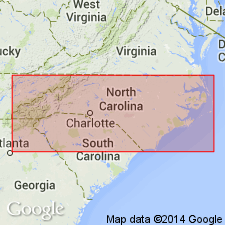
- Usage in publication:
-
- Albemarle Group*
- Modifications:
-
- Original reference
- Dominant lithology:
-
- Volcanics
- AAPG geologic province:
-
- Piedmont-Blue Ridge province
Summary:
Pg. 126, geol. map. Albemarle Group. A sequence of waterlaid pyroclastics and sediments. Typically developed west and southwest of Troy anticlinorium. Comprises (ascending) Tillery Formation, McManus Formation, and Yadkin Graywacke (all new). Overlies Uwharrie Formation (new) west and southwest of Troy anticlinorium and Efland Formation (new) east and northeast of the anticlinorium. Unconformably underlies Tater Top Group (new). Age is early Paleozoic.
[Type locality not designated.] Named for exposures near city of Albemarle, Stanly Co., in Carolina slate belt west of Deep River-Wadesboro Triassic basin, central North Carolina.
[GNC remark (ca. 1970, US geologic names lexicon, USGS Bull. 1350, p. 12): The USGS has redefined the Albemarle Group and currently designates the age as Ordovician(?) on the basis of a study now in progress [see entry under Stromquist and Sundelius (1969].]
Source: US geologic names lexicon (USGS Bull. 1350, p. 11-12); supplemental information from GNU records (USGS DDS-6; Reston GNULEX).
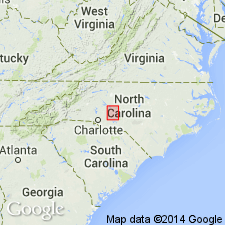
- Usage in publication:
-
- Albemarle Group
- Modifications:
-
- Revised
- Age modified
- AAPG geologic province:
-
- Piedmont-Blue Ridge province
Summary:
Albemarle Group redefined. †McManus Formation abandoned and Yadkin Graywacke reduced in rank to member of Millingport Formation. Group now consists of (ascending): Tillery Formation, Cid Formation, and Millingport Formation (new). Present in North Carolina. Age changed from early Paleozoic --to-- Ordovician(?), based on fossils and stratigraphic relations. Fossils indicate the group is of early Paleozoic age, possibly in part Cambrian(?) and Ordovician(?). Considering regional correlations and reliability of available datings, authors favor Ordovician(?) over early Paleozoic. Age assignment is not in serious conflict with isotopic ages of underlying Uwharrie Formation.
Source: Publication; Changes in stratigraphic nomenclature, 1969 (USGS Bull. 1324-A, p. A2).

- Usage in publication:
-
- Albemarle Group*
- Modifications:
-
- Revised
- Age modified
- AAPG geologic province:
-
- Piedmont-Blue Ridge province
Summary:
Albemarle Group revised to include (ascending): Tillery Formation, Cid Formation with its lower unnamed mudstone member and upper Flat Swamp Member, Floyd Church Formation, and Yadkin Formation. Millingport Formation abandoned, its members having been raised to formation status. Rb-Sr age of 540 +/-7 Ma for Badin greenstone lentil of Yadkin Formation, trilobite age of latest Proterozoic for the Floyd Church Formation, and a U-Pb zircon age of 586 +/-10 Ma for the uppermost Uwharrie Formation, which underlies the Albemarle, indicate a formal age of Late Proterozoic for the group.
Source: GNU records (USGS DDS-6; Reston GNULEX).
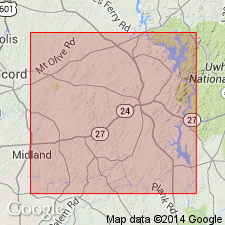
- Usage in publication:
-
- Albemarle Group
- Modifications:
-
- Revised
- AAPG geologic province:
-
- Piedmont-Blue Ridge province
Summary:
Authors adopt a modified version of the terminology established by Conley and Bain (1965) for the Albemarle Group. McManus Formation is reinstated and divided into a lower mudstone member (equivalent to Cid Formation of Stromquist and Sundelius, 1969) and the overlying and interfingering Floyd Church Member. McManus overlies Tillery Formation and gradationally underlies Yadkin Graywacke. Age not stated.
Source: GNU records (USGS DDS-6; Reston GNULEX).
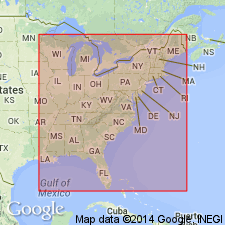
- Usage in publication:
-
- Albemarle Group*
- Modifications:
-
- Geochronologic dating
- Age modified
- AAPG geologic province:
-
- Piedmont-Blue Ridge province
Summary:
U-Pb zircon age of 586 +/-10 Ma (Wright and Seiders, 1980) obtained from upper part of bimodal volcanic rocks of Uwharrie Formation indicate that it was deposited in Late Proterozoic time. Uwharrie unconformably overlies 575-Ma Roxboro Granite. Ediacaran fossils found in upper part of Floyd Church Formation in upper part of Albemarle Group also indicate a Late Proterozoic age (Gibson and others, 1984; Gibson and Teeter, 1984). An Rb-Sr whole-rock isochron minimum age of 540 +/-7 Ma (Black, 1978; recalculated by Milton, 1984; Harris and Glover, 1988) was obtained from a mafic volcanic lentil in Yadkin Formation at top of Albemarle Group, suggesting Yadkin is Cambrian. Age of Albemarle Group, therefore, is Late Proterozoic and could be as young as Cambrian.
Source: GNU records (USGS DDS-6; Reston GNULEX).
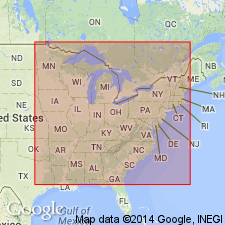
- Usage in publication:
-
- Albemarle Group*
- Modifications:
-
- Overview
- AAPG geologic province:
-
- Piedmont-Blue Ridge province
Summary:
On the correlation chart for Precambrian rocks of the conterminous United States, the Albemarle Group in the Carolina Slate Belt of the Avalonian terranes is shown to be of Late Proterozoic age (approximately 680 to 570 Ma).
Source: GNU records (USGS DDS-6; Reston GNULEX).
For more information, please contact Nancy Stamm, Geologic Names Committee Secretary.
Asterisk (*) indicates published by U.S. Geological Survey authors.
"No current usage" (†) implies that a name has been abandoned or has fallen into disuse. Former usage and, if known, replacement name given in parentheses ( ).
Slash (/) indicates name conflicts with nomenclatural guidelines (CSN, 1933; ACSN, 1961, 1970; NACSN, 1983, 2005, 2021). May be explained within brackets ([ ]).

